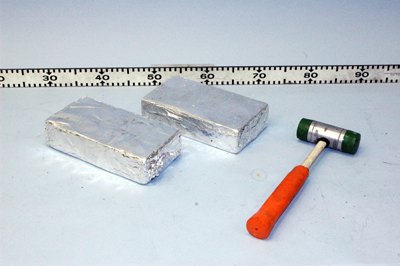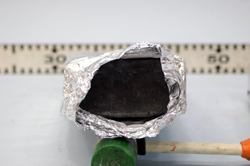|
Size: 2618
Comment:
|
← Revision 7 as of 2013-07-12 18:18:18 ⇥
Size: 2988
Comment: converted to 1.6 markup
|
| Deletions are marked like this. | Additions are marked like this. |
| Line 2: | Line 2: |
| ||<:30%>[:PiraScheme#Mechanics: Table of Mechanics Demonstration]||<:30%>[:MEEquipmentList: List of Mechanics Equipment & Supplies]||<:30%>[:Demonstrations:Lecture Demonstrations]|| | ||<:30%>[[PiraScheme#Mechanics| Table of Mechanics Demonstration]]||<:30%>[[MEEquipmentList| List of Mechanics Equipment & Supplies]]||<:30%>[[Demonstrations|Lecture Demonstrations]]|| |
| Line 7: | Line 7: |
| Newton's First Law, [:Newtons1STLaw: 1F20. Measuring Inertia] | Newton's First Law, [[Newtons1STLaw| 1F20. Measuring Inertia]] |
| Line 10: | Line 10: |
| * '''Cabinet:''' [:MechanicsCabinet:Mechanic (ME)] * '''Bay:''' [:MechanicsCabinetBayB5:(B5)] |
* '''Cabinet:''' [[MechanicsCabinet|Mechanic (ME)]] * '''Bay:''' [[MechanicsCabinetBayB5|(B5)]] |
| Line 14: | Line 14: |
| attachment: mainPhoto | {{attachment:UnknownBricks-01-400.jpg}} |
| Line 32: | Line 32: |
| 1. Place the two blocks on the table, and tell the audience which two materials are concealed before their eyes. | 1. Place the two blocks on the table, and do not tell the audience which two materials are concealed before their eyes. |
| Line 34: | Line 34: |
| 1. The lead block will barely move it at all while the wood block will go sliding across the table. 1. Ask the audience which block they think is which. 1. (Optional) Toss the light, wood block to a student. If they understand physics well enough, they shouldn't freak out. |
1. Hit the wooden block first (hard) and observe it sliding across the table and onto the floor. 1. Then hit lead block (with the same force) and observe that it barely moves at all. 1. Ask the audience what they think the blocks are made of and why one flew across the table well the other didn't move much at all. Optional: 1. Don't tell the audience anything. 1. Hit the lead brick with a b 1. Act like the wooden block is very heavy and toss it to an audience member to catch. 1. Toss the light, wood block to a student. If they understand physics well enough, they shouldn't freak out. |
| Line 44: | Line 51: |
| The lead block is much more dense than the wood block. Therefore, since the two blocks have the same dimensions, the lead block will be much heavier than the wood block. In other words, the lead block has much more inertia than the wood block. When hitting each block with the hammer, due to the large mass of the lead block, it will barely move and due to the comparitavely small mass of the wood block, it will go sliding accross the table. These ideas are quantified in Newton's second law: F = m*a, the larger the mass of the object, the less acceleration it will obtain by a given force. | The lead block is much more dense than the wood block. Therefore, since the two blocks have the same dimensions, the lead block will be much heavier than the wood block. In other words, the lead block has much more inertia than the wood block. When hitting each block with the hammer, due to the large mass of the lead block, it will barely move and due to the comparatively small mass of the wood block, it will go sliding across the table. These ideas are quantified in Newton's second law: F = m*a, the larger the mass of the object, the less acceleration it will obtain by a given force. |
| Line 46: | Line 53: |
| ||attachment: photo||attachment: photo||attachment: photo||attachment: photo|| | ||{{attachment:UnknownBricks-03-250.jpg}}||{{attachment:UnknownBricks-09-250.jpg}}|| |
| Line 49: | Line 56: |
| * [https://www.youtube.com/user/LectureDemostrations/videos?view=1 Lecture Demonstration's Youtube Channel] | * [[https://www.youtube.com/user/LectureDemostrations/videos?view=1|Lecture Demonstration's Youtube Channel]] |
| Line 56: | Line 63: |
| [:Instructional:Home] | [[Instructional|Home]] |
Unknown Bricks, 1F10.25
Topic and Concept:
Newton's First Law, 1F20. Measuring Inertia
Location:
Cabinet: Mechanic (ME)
Bay: (B5)
Shelf: #1

Abstract:
A lead brick and a wooden block(balsa wood) of the same dimensions are both wrapped in aluminum foil to look identical. Each block is then hit with a hammer. Then toss the wooden block to a student.
Equipment |
Location |
ID Number |
|
|
|
Wrapped Wood and Lead Blocks |
ME, Bay B5, Shelf #1 |
|
Rubber-Coated Mallet |
ME, Bay , Shelf # |
|
Important Setup Notes:
- N/A
Setup and Procedure:
- Place the two blocks on the table, and do not tell the audience which two materials are concealed before their eyes.
- Tell the audience you will do your best to apply equivalent forces via the hammer to each block then do it.
- Hit the wooden block first (hard) and observe it sliding across the table and onto the floor.
- Then hit lead block (with the same force) and observe that it barely moves at all.
- Ask the audience what they think the blocks are made of and why one flew across the table well the other didn't move much at all.
Optional:
- Don't tell the audience anything.
- Hit the lead brick with a b
- Act like the wooden block is very heavy and toss it to an audience member to catch.
- Toss the light, wood block to a student. If they understand physics well enough, they shouldn't freak out.
Cautions, Warnings, or Safety Concerns:
- The lead block is heavy. Don't drop it - it could cause serious damage to the floor, table, or your foot.
Discussion:
The lead block is much more dense than the wood block. Therefore, since the two blocks have the same dimensions, the lead block will be much heavier than the wood block. In other words, the lead block has much more inertia than the wood block. When hitting each block with the hammer, due to the large mass of the lead block, it will barely move and due to the comparatively small mass of the wood block, it will go sliding across the table. These ideas are quantified in Newton's second law: F = m*a, the larger the mass of the object, the less acceleration it will obtain by a given force.
|
|
Videos:
References:
- N/A

